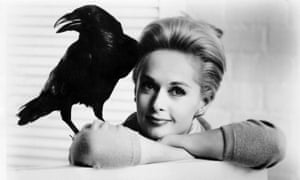Key Theory 8- Lisbet Van Zoonen.
https://www.bbc.co.uk/news/uk-46820660Key Theory 8- Lisbet Van Zoonen.
She believed that gender is constructed and not something we are born with but something we learn over time through media products such as clothes and toys, meaning that the ideas of what is male and what is female is changed over time.
She also said that women's bodies in media products are used for heterosexual male audiences, which reinforces patriarchal hegemony.
The Alfred Hitchcock Article.
Read the Alfred Hitchcock article and make notes on content, ideology and lexis. Make sure to pick out several (at least three) example sentences that you can ultimately quote in the exam!In the article Hitchcock refers to Grace Kelly as "the cool, tantalising British- or Nordic type of beauty I look for in my actresses." suggesting that the reason the Kelly was hired for the role in Hitchcock's film was more because of her good looks and had very little to do with her talent as an actress.
As well as this Hitchcock has also said that "Any man who isn't caught off guard by an english girl's sudden revelation of seductive depths doesn't know what he's been missing." This implies that Hitchcock believes that women are sex objects and they are being used in media products in order to appeal to the male dominated society.
Towards the end of the article, Hitchcock says "you judge an Englishman's status by the car he drives, which is hard luck on his female appendages..." which suggests that he think women are a sort of accessory for men to show off to others. It could also be said that he is implying that women are not supposed to leave a man's side and they must be attached to him, like an appendage, at all times.
Analyse two of the images included in this article. Consider shot type, costume, and especially the anchorage provided by the lexis of the captions. What ideological perspectives are being constructed?
This image of Hitchcock and his wife shows her looking up at him, smiling and laughing. Th angle of the image has been purposefully shot this way in order to show his dominance over her. The framing of the image shows Hitchcock above his wife to symbolise his power and his belief that women should be made to sit, smile and look beautiful.
 This image, of Deborah Karr, shows her hugging a man while they're both wearing swim suits. This image is a way of sexualising her and once again using her beauty to attract an audience. Both actors are stereotypically good looking with them woman having a curvy body and short curly hair while the man is tall, muscular and has a big build. These actors are used because it attracts the audience to this image because they want to be like these people.
This image, of Deborah Karr, shows her hugging a man while they're both wearing swim suits. This image is a way of sexualising her and once again using her beauty to attract an audience. Both actors are stereotypically good looking with them woman having a curvy body and short curly hair while the man is tall, muscular and has a big build. These actors are used because it attracts the audience to this image because they want to be like these people.
How does this interview reflect the representation of women in 1964? How does it differ from how women are represented in 2019?
The interview shows that women in 1964 were never regarded as intelligent people. Men, such as Hitchcock, would want them for their good looks and capability as a house wife and mother.
This differs in 2019 because more and more women are being recognised for their intelligence rather than the way they looks. As well as this, there are much more women in the work place than there was in 1964, many of them in positions of high power.
In what ways does this article confirm patriarchal hegemonic ideologies relating to women?
The article conforms to patriarchal hegemonic because it implies that British women need to be reminded how beautiful they are by men. This also suggests that women need men in order to be for-filled
Research Alfred Hitchcock, particularly accusations made about him by the actor Tippi Hedren. Discuss your findings.
 Tippi Hedren has revealed how Alfred Hitchcock allegedly sexually assaulted her while they were working on the films The Birds and Marnie.
Tippi Hedren has revealed how Alfred Hitchcock allegedly sexually assaulted her while they were working on the films The Birds and Marnie.
According to the Daily Mail, Hitchcock’s abusive behaviour began when he cast Hedren in The Birds, her first film and Hitchcock’s follow-up to Psycho.
Hedren alleges that the director ordered other cast members not to socialise with her or touch her, and grew petulant if he saw her talking to other men.

Comments
Post a Comment